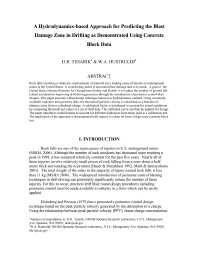Mining Publication: A Hydrodynamics-Based Approach for Predicting the Blast Damage Zone in Drifting as Demonstrated Using Concrete Block Data
Original creation date: August 2009
Rock falls involving a relatively small amount of material are a leading cause of injuries in underground mines in the United States. A contributing factor is unwanted blast damage and over-break. A goal of the United States National Institute for Occupational Safety and Health is to reduce the number of ground fall-related accidents by improving drift driving practices through the introduction of perimeter control blast designs. This paper presents a blast design technique based on a hydrodynamic method. Using commonly available explosive and geometry data, the theoretical particle velocity is calculated as a function of distance away from a cylindrical charge. A calibration factor is introduced to account for actual conditions by comparing the predicted values to a set of field data. The calibrated curve can then be applied for design. The paper introduces modifications to account for different explosives from those used in a calibration test. The application of the approach is demonstrated with respect to a data set from a large-scale concrete block test.
Authors: DR Tesarik, WA Hustrulid
Peer Reviewed Journal Article - August 2009
NIOSHTIC2 Number: 20036018
Blasting Fragm 2009 Aug; 3(2):141-166
See Also
- An Analysis and Prevention of Flyrock Accidents in Surface Blasting Operations
- Analysis of Multiple Seam Stability
- A Case Study Examination of Two Blast Rounds at a Nevada Gold Mine
- Determination of Sound Exposures (DOSES): Software Manual and Implementation Guide
- Make it Safer with Roof Screen
- Optimizing Secondary Roof Support with the NIOSH Support Technology Optimization Program (STOP)
- Proceedings: New Technology for Ground Control in Multiple-seam Mining
- Task Analysis
- Technology News 483 - Safety Training Tools for Rock Scaling Personnel
- Technology News 536 - NIOSH Develops New Software to Analyze and Reduce Noise Exposure
- Content source: National Institute for Occupational Safety and Health, Mining Program


 ShareCompartir
ShareCompartir
